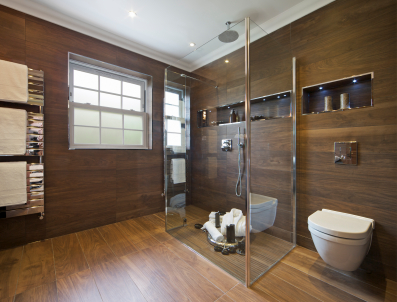To change the look and feel of a home without spending huge money on renovations, homeowners are turning to tiles. From country to modern to chic, every type of design aesthetic can be updated with new tiles.
Porcelain Wood Tiles
Porcelain tiles that emulate wood grain are the newest trends available to homeowners (also known as “faux wood”). It has been building for a few years with tiles being introduced as a modern update to wood floors. Now, wood tiles come in different shapes and sizes. From walls to floors to ceilings, porcelain wood tiles are being used all over the home. Mixed wood tiles are the newest trends in wood. Light tiles that appear distressed and aged are popular. It can transform a kitchen or bath into a coastal-cottage inspired home design. It’s the new and improved shabby chic look.

With the popularity of reclaimed wood, homeowners want that aged patina in their homes, but it can be difficult to find the perfect piece without scouring the countryside personally. Wood tile gives homeowners choices that they wouldn’t be able to find naturally. Colors of porcelain wood tiles range from faded-blue, weathered-gray and light brown to white, rust or tan. Weathered, peeling and distressed wood has hazards like paint chips, lead from old paint or splinters. With wood tile, homeowners get all the good attributes of weathered wood with none of the bad.
Painted Glass
Instead of glass mosaic tiles, homeowners now get a more ethereal tile choice for the bathroom or as a tile for the back splash in the kitchen. The back of the glass tile is painted with the color of choice. This gives the tile a shiny patina that fits in with polished kitchens. High-gloss counter tops and shiny appliances are a growing trend that allows the addition of these stunning pieces of glass. These glass tiles fit in with modern kitchen designs quite beautifully.
In the bathroom, these glass tiles can add to the feel of a seaside retreat. Popular color choices like blue, green or sand can make the homeowner feel like they are in a cottage by the sea. It gives an added dimension that can’t be matched with traditional tiles.
Faux Stone
Homeowners that might want the look of stone flooring without the disadvantages are turning to a ceramic alternative. Faux stone has the timeless appearance of traditional slate, travertine or sandstone flooring with none of the hassles.
Natural stone needs to be sealed against damage repeated through the life of the floor, and still after sealing, it is not completely resistant to chemicals or stains. Something as simple as lemon juice can stain a natural stone floor. Each natural stone tile might be a different color than the next. There’s no real uniformity to the color scheme of the tiles. For some homeowners, that can present a design problem.
Faux stone tiles are easier to install. They are stain-resistant without the constant sealing that natural stone requires. They cost less to buy and to install than natural stone. They are becoming a natural choice for homeowners who don’t want the fuss or expense of natural stone floors, walls or counter tops. Faux stone tiles can be used to create a floor or a wall with uniform color and design.
Tags: ceramic tile, clay tiles, concrete tiles, contemporary, faux stone tiles, faux wood tiles, modern, painted glass tiles, porcelain wood tiles, tile, trending, wood tiles

